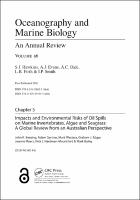Chapter 5 Impacts and Environmental Risks of Oil Spills on Marine Invertebrates, Algae and Seagrass
Proposal review
A Global Review from an Australian Perspective
Author(s)
Keesing, John K.
Gartner, Adam
Westera, Mark
Edgar, Graham J.
Myers, Joanne
Hardman-Mountford, Nick J.
Bailey, Mark
Language
EnglishAbstract
Marine invertebrates and macrophytes are sensitive to the toxic effects of oil. Depending on the intensity, duration and circumstances of the exposure, they can suffer high levels of initial mortality together with prolonged sublethal effects that can act at individual, population and community levels. Under some circumstances, recovery from these impacts can take years to decades. However, effects are variable because some taxa are less sensitive than others, and many factors can mitigate the degree of exposure, meaning that impacts are moderate in many cases, and recovery occurs within a few years. Exposure is affected by a myriad of factors including: type and amount of oil, extent of weathering, persistence of exposure, application of dispersants or other clean-up measures, habitat type, temperature and depth, species present and their stage of development or maturity, and processes of recolonisation, particularly recruitment. Almost every oil spill is unique in terms of its impact because of differing levels of exposure and the type of habitats, communities and species assemblages in the receiving environment. Between 1970 and February 2017, there were 51 significant oil spills in Australia. Five occurred offshore with negligible likely or expected impacts. Of the others, only 24 of the spills were studied in detail, while 19 had only cursory or no assessment despite the potential for oil spills to impact the marine environment. The majority were limited to temperate waters, although 10 of the 14 spills since 2000 were in tropical coastal or offshore areas, seven were in north Queensland in areas close to the Great Barrier Reef. All four spills that have occurred from offshore petroleum industry infrastructure have occurred since 2009. In Australia, as elsewhere, a prespill need exists to assess the risk of a spill, establish environmental baselines, determine the likely exposure of the receiving environment, and test the toxicity of the oil against key animal and plant species in the area of potential impact. Subsequent to any spill, the baseline provides a reference for targeted impact monitoring.
Keywords
oil spills, marine life, marine invertebrates, algae, seagrass, ocean toxicity, marine habitats, Australian marine life, oil spill AustraliaISBN
9780429454455, 9781138318625Publisher
Taylor & FrancisPublisher website
https://taylorandfrancis.com/Publication date and place
2018Imprint
CRC PressClassification
Marine biology
Oceanography (seas and oceans)
Wildlife: aquatic creatures: general interest
Environmental science, engineering and technology


 Download
Download